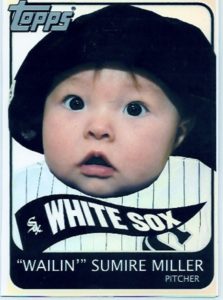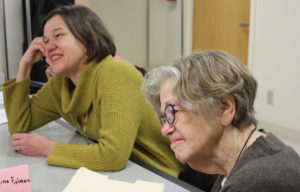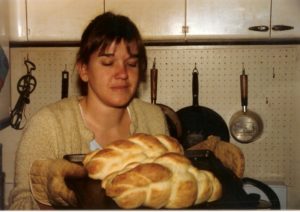Mondays with Mike: Home made bliss
December 24, 2018 • 4 Comments • Posted in Mike Knezovich, Mondays with Mike

The home made group, 2018.
On December 23, 1983, I gifted Beth an elegant three-speed Peugeot bicycle, replete with nifty folding baskets, for her birthday. And then I gifted me by asking her to marry me. She said yes.
The next day, the low temperature in Chicago was -25, the high was -11. That’s temperature, not wind chill. The wind chill was anywhere from -60 to -80, depending on where you were. We started in Urbana, Illinois, driving north to Beth’s mom’s house. I drove a skanky old Pontiac Ventura. I had to bungee a big piece of cardboard to the front of the radiator to get the engine warm enough to run. When we stopped for gas halfway on the trip, it felt like an existential threat just being out of the car and pumping gas.
When we arrived, we found a full house that would eventually overflow with various Finke families from around the world braving the elements to get home for home made Christmas. A year or two earlier, Beth had suggested that given the burgeoning size of the family and the size of the Christmas event, it might make sense for everyone to draw a name, and then make a present for the person they drew. Back then, the cost limit was $5, though the limit has always been more of a suggestion just to keep cost down.

This year, our nephew Brian drew my name. He created a baseball card that featured his newborn daughter as a White Sox player. Pretty nice! Of course, he’s a Cub fan, so he took shots at my team on the back of the card. He’ll regret it when I get his name.
It was so crowded in Flo’s (Beth’s mom’s) house that Beth and I slept under the dining room table, next to some kids. I don’t remember who they were, because, well, there were and are so many of them.
The only other thing I remember about that particular Christmas is I was drafted into being Santa Claus and handing out the gifts.
Except for the Santa Claus part, we’ve done it every single year. It’s controlled chaos, because as one group of jumping bean little kids moved up, another group replaced them. The kids we slept next to on the floor now have kids. Yikes.
The gifts have run the gamut from “homemade” (presents that are only homemade in the sense that say, the giver signed the gift) to a literal footstool—made from the cured legs of a deer that a family hunter made. (I’m not kidding.)
For newcomers to Beth’s family, it can be a little intimidating and well, freaking nuts. But it always eventually grows on everyone, including me.
And so, this past Saturday, we gathered at a hotel meeting room (sparing whoever would have otherwise hosted it), had a light lunch, and as always, opened presents one by one. The thing about it is you have to think about the person—you might give something serious or something that teases—but you have to think about the person a little more than you would if you were just buying something; what you know about them, what you like, what you don’t.
It’s pretty cool.
And every year, it’s different but weirdly, comfortingly, the same. Things change. Between Christmases we triumph, we stumble, we lose people. But home made Christmas abides.
Thanks Beth, and thanks Finke nation.



